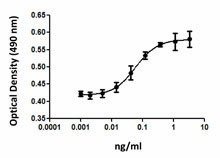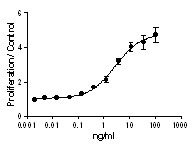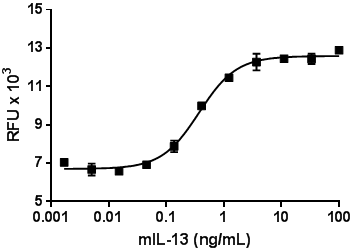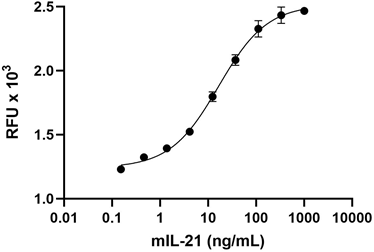- Regulatory Status
- RUO
- Other Names
- Interleukin 5
- Ave. Rating
- Submit a Review
- Product Citations
- publications

-

BCL-1 cell proliferation induced by mouse IL-5.
IL-5 is a homodimeric glycoprotein that was initially identified by its ability to support the in vitro growth and differentiation of mouse B cells and eosinophils. IL-5 induces eosinophil progenitor cell proliferation, terminal differentiation, and activation. In animal models of allergic diseases or helminth infection, IL-5 induces a massive proliferation of eosinophil progenitors in the bone marrow, promotes eosinophil recruitment with eotaxins, and prolongs eosinophil survival in local tissues. IL-5 regulates genes involved in the B cell terminal differentiation. IL-5 induces CD38-activated splenic B cells to differentiate into immunoglobulin M-secreting cells and go through m to g1 class switch recombination at the DNA level, resulting in immunoglobulin G1 (IgG1) production. IL-5 binds the IL-5R complex, which consists of an IL-5Rα chain specific for IL-5 and a common β-chain that is shared by the receptors for IL-3 and GM-CSF. The alpha subunit is required for ligand-specific binding whereas association with the beta subunit results in increased binding affinity. IL-5 plays important roles in the pathogenesis of asthma, hypereosinophilic syndromes, and eosinophil-dependent inflammatory disease.
Product DetailsProduct Details
- Source
- Mouse IL-5, amino acids Met21-Gly133 (NM_010558.1), was expressed in insect cells.
- Molecular Mass
- The 113 amino acid recombinant protein has a predicted molecular mass of approximately 13.1 kD. The DTT-reduced protein migrates between 13 to 20 kD and the non-reduced protein at approximately 40 kD by SDS-PAGE. The N-terminal amino acid is Met.
- Purity
- >98%, as determined by Coomassie stained SDS-PAGE.
- Formulation
- 0.22 µm filtered protein solution is in PBS, pH 7.2.
- Endotoxin Level
- Less than 0.01 ng per µg cytokine as determined by the LAL method.
- Concentration
- 10 and 25 µg sizes are bottled at 200 µg/mL. 100 µg size and larger sizes are lot-specific and bottled at the concentration indicated on the vial. To obtain lot-specific concentration and expiration, please enter the lot number in our Certificate of Analysis online tool.
- Storage & Handling
- Unopened vial can be stored between 2°C and 8°C for up to 2 weeks, at -20°C for up to six months, or at -70°C or colder until the expiration date. For maximum results, quick spin vial prior to opening. The protein can be aliquoted and stored at -20°C or colder. Stock solutions can also be prepared at 50 - 100 µg/mL in appropriate sterile buffer, carrier protein such as 0.2 - 1% BSA or HSA can be added when preparing the stock solution. Aliquots can be stored between 2°C and 8°C for up to one week and stored at -20°C or colder for up to 3 months. Avoid repeated freeze/thaw cycles.
- Activity
- Bioactivity was measured by its property to stimulate the proliferation of BCL1 cells in a dose dependent manner. ED50 = 0.03 - 0.15 ng/ml, corresponding to a specific activity of 0.66 - 3.3 x 107 units/mg.
- Application
-
Bioassay
- Application Notes
-
BioLegend carrier-free recombinant proteins provided in liquid format are shipped on blue-ice. Our comparison testing data indicates that when handled and stored as recommended, the liquid format has equal or better stability and shelf-life compared to commercially available lyophilized proteins after reconstitution. Our liquid proteins are verified in-house to maintain activity after shipping on blue ice and are backed by our 100% satisfaction guarantee. If you have any concerns, contact us at tech@biolegend.com.
- Product Citations
-
Antigen Details
- Structure
- Homodimeric cytokine
- Distribution
-
Activated Th2 cells, mast cells, eosinophils, and basophils. In addition, newly identified IL-5 producing cells are: natural helper cells or nuocytes (lately identified as type II innate lymphoid cells), MPPtype2, and Ih2 cells.
- Function
- IL-5 regulates the production of eosinophils from purified hematopoieitic progenitors and regulates genes involved in the B cell terminal differentiation. IL-25 and IL-33 induce Th2 cytokines, among them IL-5.
- Interaction
- Eosinophils, B cells, basophils, and activated T cells.
- Ligand/Receptor
- Heterodimer IL-5Rα (CD125); β-subunit (CDw131) in common with IL-3R, GM-CSFR
- Cell Type
- Embryonic Stem Cells, Hematopoietic stem and progenitors
- Biology Area
- Cell Biology, Immunology, Signal Transduction, Stem Cells
- Molecular Family
- Cytokines/Chemokines
- Antigen References
-
1. Lopez AF, et al. 1988. J. Exp. Med. 167:219.
2. Horikawa K and Takatsu K, 2006. Immunology 118:497.
3. Moro, K, et al. 2010. Nature 463:540.
4. Neill, DR, et al. 2010. Nature 464:1367.
5. Saenz SA, et al. 2010. Nature 464:1362.
6. Ikutai M, et al. 2012. J. Immunol. 188:703.
7. Yazuda K, et al. 2012. P. Nat. Acad. Sci. USA 109:3451. - Gene ID
- 16191 View all products for this Gene ID
- Specificity (DOES NOT SHOW ON TDS):
- IL-5
- Specificity Alt (DOES NOT SHOW ON TDS):
- IL-5
- App Abbreviation (DOES NOT SHOW ON TDS):
- BA
- UniProt
- View information about IL-5 on UniProt.org
Related FAQs
- Why choose BioLegend recombinant proteins?
-
• Each lot of product is quality-tested for bioactivity as indicated on the data sheet.
• Greater than 95% Purity or higher, tested on every lot of product.
• 100% Satisfaction Guarantee for quality performance, stability, and consistency.
• Ready-to-use liquid format saves time and reduces challenges associated with reconstitution.
• Bulk and customization available. Contact us.
• Learn more about our Recombinant Proteins. - How does the activity of your recombinant proteins compare to competitors?
-
We quality control each and every lot of recombinant protein. Not only do we check its bioactivity, but we also compare it against other commercially available recombinant proteins. We make sure each recombinant protein’s activity is at least as good as or better than the competition’s. In order to provide you with the best possible product, we ensure that our testing process is rigorous and thorough. If you’re curious and eager to make the switch to BioLegend recombinants, contact your sales representative today!
- What is the specific activity or ED50 of my recombinant protein?
-
The specific activity range of the protein is indicated on the product datasheets. Because the exact activity values on a per unit basis can largely fluctuate depending on a number of factors, including the nature of the assay, cell density, age of cells/passage number, culture media used, and end user technique, the specific activity is best defined as a range and we guarantee the specific activity of all our lots will be within the range indicated on the datasheet. Please note this only applies to recombinants labeled for use in bioassays. ELISA standard recombinant proteins are not recommended for bioassay usage as they are not tested for these applications.
- Have your recombinants been tested for stability?
-
Our testing shows that the recombinant proteins are able to withstand room temperature for a week without losing activity. In addition the recombinant proteins were also found to withstand four cycles of freeze and thaw without losing activity.
- Does specific activity of a recombinant protein vary between lots?
-
Specific activity will vary for each lot and for the type of experiment that is done to validate it, but all passed lots will have activity within the established ED50 range for the product and we guarantee that our products will have lot-to-lot consistency. Please conduct an experiment-specific validation to find the optimal ED50 for your system.
- How do you convert activity as an ED50 in ng/ml to a specific activity in Units/mg?
-
Use formula Specific activity (Units/mg) = 10^6/ ED50 (ng/mL)
 Login / Register
Login / Register 














Follow Us